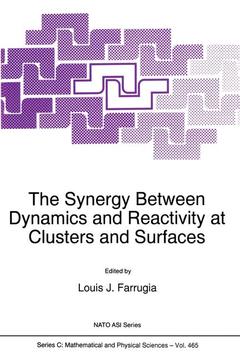Description
The Synergy Between Dynamics and Reactivity at Clusters and Surfaces, Softcover reprint of the original 1st ed. 1995
Coll. Nato Science Series C:, Vol. 465
Coordinator: Farrugia L.J.
Language: French
Subjects for The Synergy Between Dynamics and Reactivity at Clusters...:
Keywords
Osmium; Rhenium; Ruthenium; adsorption; bonding; carbon; catalysis; gold; metals; nickel; platinum; silver; stereochemistry; structure; transition metal
Publication date: 10-2012
368 p. · 16x24 cm · Paperback
368 p. · 16x24 cm · Paperback
Description
/li>Contents
/li>
The analogy between the chemistry of molecular transition metal clusters and the processes of chemisorption and catalysis at metal surfaces (the Cluster Surface analogy) has for a number of years provided an interplay between experimental and theoretical inorganic and physical chemists. This collaborative approach has born fruit in the use of well defined modes of metal-ligand bonding in discrete molecular clusters, models for metal-ligand binding on surfaces. Some of the key topics discussed in The Synergy betweenDynamics and Reactivity at Clusters and Surfaces are: (1) Mechanisms of the fluxional behaviour in clusters in the liquid phase and the connections with diffusion processes on extended surfaces. The role of metal-metal bond breaking in diffusion. (2) Analogies in the structure of chemisorbed species and related ligands on metallic clusters. (3) Analogies between benzene surface chemistry on extended metal surfaces and on metal surfaces in molecular cluster compounds with particular reference to structural distortions. (4) The role of mobile precursors for dissociation of chemisorption on extended metals and on clusters. Are there analogies in the ligand attachment during cluster compound synthesis? (5) The role of defect sites on metal surfaces in catalyzing chemical reactions and the connection to the special bonding properties of sites on metal clusters having lowest metal-metal coordination. (6) The size of metal clusters needed to mimic surface phenomena on bulk metal surfaces. Different sites needed for different phenomena.
Can We Put the Cluster-Surface Analogy on a Sound Structural Basis?.- An Atomic View of Diffusion on Metal Surfaces.- Dynamics of the Desorption of Carbon Monoxide from Size-Selected Supported Plahnum Clusters.- NMR Investigations of Binding of Aromatics at Catalytic Surfaces.- From Molecular Carbonyl Clusters to Supported Metal Particles.- Cluster Equilibria. Relevance to the Energetics and Reactivity of Surface Bound Fragments.- Reactions and Dynamics of Ruthenium Clusters.- Unusual Ligand Transformations and Rearrangements in Heterometallic Clusters.- Hydride Mobility and its Relation to Structure and Reactivity in Polymetallic Clusters.- Structural Variations in Tetranuclear Platinum-Ruthenium Clusters.- Intramolecular Exchange in D9 Metal Carbonyl Clusters.- Static and Dynamic Stereochemistry of the Organometallic Cluster Complexes [(CpCo)3(?3-Arene)].- Nmr Studies on the Dynamic Behaviour in Solution of Rhenium-Platinum Mixed Metal Clusters Containing P-Donor Ligands.- Organometallic Migrations over Clusters and Surfaces.- Structure, Melting and Reactivity of Nickel Clusters from Numerical Simulations.- Heterodox Bonding Effects between Transition Metal Atoms.- Periodic Hartree-Fock Calculations of the Adsorption of Small Molecules on Tio2.- An Overview of the Mo Architectures of Metal Clusters Using Graphic Tools.- Molecular Orbital Approach of Skeletal Isomerism and Polyhedral Rearrangements in Some Organomeallic Clusters.- Some Old and New Redox Reactions of Polynuclear Organometallic Complexes.- Arene Cluster Compounds.- Silver and Gold Clusters Stabilized by Fe(CO)4 Ligands.- Reactions of Silylalkynes with Triosmium and Triruthenium Clusters.
© 2024 LAVOISIER S.A.S.




